
Removing an Old Chimney: Should You Do It? Pros, Cons, and FAQs
Last Updated: Feb 8, 2025Removing an old chimney is a good move toward making a home healthy and energy-efficient. This project can be a costly and lengthy undertaking because, often, the chimney structure is load-bearing. If done wrong, it can cause severe structural damage to your home. Before removing your chimney, you should first understand if it's the right move for your home in terms of cost, safety, and structural integrity.
Table of Contents
- Is it a good idea to remove an unused chimney?
- What are the top reasons to remove an old chimney?
- Should I seal my chimney or remove it altogether?
- How do you remove a chimney from inside a house?
- How do you manage waste and debris when removing a chimney?
- What kind of experts should I consult before removing my chimney?
- What paperwork do I need before removing my chimney?
- How much does it cost to remove a chimney?
Is it a good idea to remove an unused chimney?
Yes, it is generally a good idea to remove an old chimney. An unused chimney can cause serious problems, including heat loss, roof leaks, and wasted space in the home.
Even in-use chimneys are only sometimes the best option as a primary heating source. Wood-burning fireplaces send 85% of their energy out of the chimney. Gas fireplaces aren't much better, with new literature linking natural gas appliances to dangerous levels of nitrogen oxide and carbon monoxide.

What are the top reasons to remove an old chimney?
There are six main reasons for removing an old chimney: heat loss through the chimney flue, heat loss through conduction, reclaiming space in the home, roof leakage, a damaged chimney stack, and ordinances and certifications.
Losing heat through the chimney flue: An unused and unsealed chimney wastes energy like a small opened window. Even a sealed chimney is losing air through the masonry or any gaps in the seal.
Losing heat through conduction from heating the thermal mass of the chimney stack: Stonework is a fantastic conductor of indoor space heating, which is wasted when the chimney stack is sticking out the top of your roof.
Reclaiming wasted space in the home: Chimneys can take up large amounts of floor space inside a house, particularly larger chimneys. Removing the chimney breast from multiple floors can be a game-changer for homes short of space.
Roof leakage: Chimneys are one of the most common causes of roof leaks, and this risk increases as the chimney ages.
A damaged chimney stack: Chimneys are skinny pillars exposed to the elements, so, unsurprisingly, they are prone to damage. A damaged chimney can cause water leaks, air leaks, and the risk of falling debris.
Ordinances and certifications: Since chimneys are often a source of emissions and pollution, some cities don't allow them in their building code. If you're seeking a home certification like LEED, check to make sure the fuel source for your fireplace doesn't cost you LEED points.

Should I seal my chimney or remove it altogether?
When choosing whether to seal and remove just the top section of your chimney or remove the chimney breast below the roof line, there are many factors to consider. Use this chart to weigh your options.
Fireplaces & Stoves
Find a wide variety of researched and vetted wood stoves products that help address heating and home comfort.

Drolet Escape 1800-I Wood Stove Insert Trio (25ft) DB03127K
Drolet
Out of Stock

Drolet HT-3000 Wood Burning Stove DB07300
Drolet
Out of Stock

Drolet Escape 1500-I Wood Insert Trio (25 FT) DB03137K
Drolet
Out of Stock

Drolet Escape 1800-I Wood Insert DB03125
Drolet
Out of Stock

Drolet Deco II Wood Stove DB03205
Drolet
In Stock

Drolet Escape 1800-I Wood Insert Trio (35 FT) DB03128K
Drolet
Out of Stock

Drolet Bistro Wood Burning Cookstove DB04815
Drolet
Out of Stock

Drolet Escape 1500-I Wood Insert Trio (35 FT) DB03137K3
Drolet
Out of Stock

Drolet Deco Nano Wood Burning Stove DB03215
Drolet
In Stock

Drolet Columbia II Wood Burning Stove DB03016
Drolet
Out of Stock

How do you remove a chimney from inside a house?
Removing a chimney inside a home is done by dismantling it brick by brick from top to bottom. It has unique challenges that distinguish it from a traditional demolition job.

Before you start demolition on each floor, you'll likely need to install temporary walls to compensate for the structural support of the chimney. Permanent structural walls or beams should be installed after the chimney demolition is complete. During demolition, take extra care to make sure debris isn't falling down the chimney onto any heads. And get a decently sized team to ensure everyone is appropriately spotted and the debris is taken care of as the project progresses.
Consult with a structural engineer before taking on this project. After consulting with your expert, you'll better understand whether this is possible in your home. If you have a chimney along an outside wall, for example, sometimes the structural damage is too costly to justify the project. In that case, removing the stack and sealing the top might be the smarter option.

How do you manage waste and debris when removing a chimney?
Removing a chimney creates a lot of waste - about a dumpster trailer full for the average home. Consider an oversized dumpster if you're removing the breast from one or more floors or a smaller dumpster if you're removing just the chimney stack above the roof. Anticipate a variety of waste, including bricks, stone, cinderblocks, tile, drywall, or lumber.

Before securing your dumpster, consider if some of the "waste" material might live a full second life. Ask your contractor or local masonry companies who might have a use for the material. Another option is to post an ad on a social listing site. There are millions of uses for old brick and stone, and some crafty homeowners might be happy to have it.
What kind of experts should I consult before removing my chimney?
Removing a chimney is a costly and risky undertaking, so it's essential that you first consult with the right experts. There are four experts you should consider contacting: a structural expert, a masonry expert, a local code administrator, and a contractor.
A structural expert can explain any concerns with removing the breast from one or more floors. They might tell you where to put up temporary walls during demolition, what type of structural support you'll need to install after removal, or they might even tell you not to take out the chimney.
A masonry expert can help you decide between removing or repairing your chimney. They can also help you find a suitable second home for the stone and brick debris.
A local code administrator can ensure you obtain the correct documents and permits to remove your chimney. Historical homes, for example, might need special permission from a Preservation Review Board.
And lastly, find a contractor that's on the same page as you. Since chimney removal can be such an involved job, especially if you're removing the flue and breast from inside the house, prioritize a contractor who's done this type of job before. If you're renovating your home and hoping to pursue a home rating like LEED, Net Zero, or Passive House, look for a contractor who understands these programs and shares your goals for your home.

What paperwork do I need before removing my chimney?
Removing a chimney is challenging, especially if it is removed below the roof and down to any lower levels. To avoid damage, injury, or legal trouble, you should consider five pieces of paperwork before starting the project: a building permit, blueprints, liability insurance, a disposal permit, and home certifications.
A building permit: make sure you have permission from your city, your housing association, your local heritage office, or anyone with authority to tell you what to do on your property.
Blueprints: this can warn you of any structural considerations, including any shared wall concerns if you don't have a fully detached home. Your local public official's office might be able to help you track this down since the original building permit for your home would have needed to include blueprints.
Liability insurance: any contractor you hire needs to have at least liability insurance to avoid all liability falling on you in the case of an accident or injury. This includes events during the renovation or demolition and problems with the completed job for months or years afterward.
A disposal permit: Some jurisdictions require a disposal permit if you're disposing of any material that might endanger workers or the environment. This might include roof shingles, asbestos-containing materials, sharp things like broken glass, and oil-soaked material. The fee is usually small, so check the solid waste commission in your area before renting a dumpster.
Certifications: check that your chosen contractor has credentials or experience that qualify them for a challenging chimney removal. Also, consider if you're trying to qualify your home for certifications like Net Zero, LEED, or Passive House - your contractor should be familiar with these programs to ensure the chimney removal project doesn't disqualify you.
How much does it cost to remove a chimney?
The cost of this project depends on how much of the chimney you are removing from your home. Removing a chimney stack can cost as little as $1000, including sealing the gap and removing the demolition waste. Removing a load-bearing chimney stack and breast from one or more floors could cost about $5000 or even into the five-figure range.
Removing a chimney can be a simple or complicated project. In either case, please consult with the right experts before taking it on.
Rise
At Rise, we strive to make sustainable home improvement easy and accessible for everyone. Whether you're building or renovating, our thoroughly vetted building products will help you reduce your carbon footprint, lower energy costs, and create a more sustainable living or working environment.
